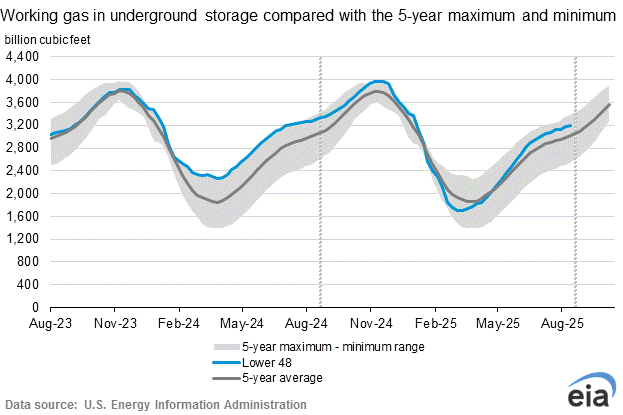
Posted on 12/05/2014 4:59:31 AM PST by thackney
Working gas in storage was 3,410 Bcf as of Friday, November 28, 2014, according to EIA estimates. This represents a net decline of 22 Bcf from the previous week. Stocks were 227 Bcf less than last year at this time and 372 Bcf below the 5-year average of 3,782 Bcf. In the East Region, stocks were 183 Bcf below the 5-year average following net withdrawals of 34 Bcf. Stocks in the Producing Region were 145 Bcf below the 5-year average of 1,247 Bcf after a net injection of 11 Bcf. Stocks in the West Region were 44 Bcf below the 5-year average after a net addition of 1 Bcf. At 3,410 Bcf, total working gas is below the 5-year historical range.

Most existing gas storage in the United States is in depleted natural gas or oil fields that are close to consumption centers. Conversion of a field from production to storage duty takes advantage of existing wells, gathering systems, and pipeline connections. Depleted oil and gas reservoirs are the most commonly used underground storage sites because of their wide availability.
In some areas, most notably the Midwestern United States, natural aquifers have been converted to gas storage reservoirs. An aquifer is suitable for gas storage if the water bearing sedimentary rock formation is overlaid with an impermeable cap rock. While the geology of aquifers is similar to depleted production fields, their use in gas storage usually requires more base (cushion) gas and greater monitoring of withdrawal and injection performance. Deliverability rates may be enhanced by the presence of an active water drive.
Salt caverns provide very high withdrawal and injection rates relative to their working gas capacity. Base gas requirements are relatively low. The large majority of salt cavern storage facilities have been developed in salt dome formations located in the Gulf Coast states. Salt caverns have also been leached from bedded salt formations in Northeastern, Midwestern, and Southwestern states. Cavern construction is more costly than depleted field conversions when measured on the basis of dollars per thousand cubic feet of working gas capacity, but the ability to perform several withdrawal and injection cycles each year reduces the per-unit cost of each thousand cubic feet of gas injected and withdrawn.
There have been efforts to use abandoned mines to store natural gas, with at least one such facility having been in use in the United States in the past. Further, the potential for commercial use of hard-rock cavern storage is currently undergoing testing. None are commercially operational as natural gas storage sites at the present time.
Figure 1 is a stylized representation of the various types of underground storage facilities, while Figure 2 shows the location of the nearly 400 active storage facilities in the Lower 48 States.


Disclaimer: Opinions posted on Free Republic are those of the individual posters and do not necessarily represent the opinion of Free Republic or its management. All materials posted herein are protected by copyright law and the exemption for fair use of copyrighted works.